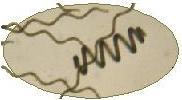|

A Rectangular basin with round corners
|
|
The big problem about basins is: what material to use for making the waterproof bottoms and side-walls?
There is no single answer.
The basin design which has proven to be
the most satisfactory is the rectangular
basin with rounded corners having a dividing
wall running through the long axis of the
basin but terminated one half the width of
the basin just before each end so as to create
a sort of race track around which the culture
can be pushed by paddlewheels. This design
can be used for basins of one square meter
area up to (and probably exceeding) five
hectares in area.
Remember, one needs about one square meter
of basin area per child.
|
A Spirulina culture must be mixed continuously
during the daylight hours for several reasons:

A Spirulina culture must be mixed
Prarticularly during Inoculum production
step

|
|
The culture, during the day, must be mixed
|
|
|
(I) to insure that the nutrients in the culture
medium will always be in contact with the
algae so that the supply of nutrients wilI not
be a factor limiting growth,
(2) to move the algal filaments up into the
zone where sunlight penetrates and photosynthesis can take place, but
(3) also to move the filaments downward in
the water column to where the diurnishing light cannot cause
photolysis (or photon burning) of the photosynthetic
pigments in Spirulina, finalIy
(4) so that the algae cannot congregate into
dense flocs where the inner filaments are deprived of
light and nutrients to the extent that they
give off large quantities of polysaccharides
and die, thus providing a rich environment
for bacteria that eventually can destroy
the culture. All this means that the bottom
and sides not only be waterproof but also
resist being eroded by the moving water
Stirred by muscle energy

A round basin in Madras (India)
Round basins of the kind used for sewage treatment have
been used, chiefly in Taiwan
and India. These
are stirred by rotating arms
like spokes
of a wheel ( called a Segner
Wheel). However,
the stirring paddles near the
center of the
basin rotate very slowly, resulting
in slow
growth rate, while those near
the perimeter
travel so fast that they risk
tearing apart
the algal filaments (more than
30 centimeters
per second). Hence, round basins
are limited
to about 80 meters in diameter
.

A round basin in Taiwan
|
|
On a gentle hillside it is possible to lay
narrow concrete basins parallel to the hillside
with the head of one basin joining the tail
of the basin just above it - like a long
snake leisurely descending a large sand dune.
This was tried at Casa Grande near Trujillo
in Peru in the nineteen eighties. Two problems
present themselves. One, you have to pump
the culture from the bottom of the hill to
the top during the daytime, and, two, there
has to be a large reservoir at the bottom
to receive the culture for the night in case
the pump stops. This can be made simply by
raising the side and end walls of the last
basin section high enough to contain the
entire culture. The pump used, because of
the force required, had a tendency to break
the algal filaments (this system originally
used for culturing Scenedesmus). A solution
would be to use a large-diameter Archemedian
Screw to lift the culture instead.
|
Stirred by broom

A Basin made of polyethylene plastic film (photo: Claude Darcas)
Basins up to about 100 square meters can
be made with a roll of black, food grade,
polyethylene plastic film one half millimeter
thick simply by attaching it to a wooden frame
about 40-centimeters high which outlines
the basin. The dividing wall to form the
racetrack can be of concrete blocks. Larger
basins require heavier membranes to resist
tearing when entered by persons cleaning
out the basins, to give longer service lifetimes
as the geo-membranes used for large basins
are costly, and to guard against fermentation
gases lifting the membrane and causing troublesome
"islands" near any small punctures
in the membrane. The cost of 0.3 mm polyethylene,
which can be used for basins up to about
30 m², is about 1 dollar per square meter.
For the half-millimeter films, guaranteed
for 15 years against ultra violet damage,
the cost is around 5 dollars per square meter.
Heavy duty geo-membranes are even more expensive.
|
|
The Romans built basins with stone and mortar which hold water to this day - but cost
probably was never taken into consideration.
Their manpower cost only a minimum amount
of food per day and their materials they
took from nature. Concrete basins have been
constructed recently in Benin, Africa, at
a cost of $ 49 per square meter; as opposed
to $ 6 per square meter for plastic film
construction (film and frame complete). I
believe that it is possible to make a 5-centimeter
thick concrete slab having 7-centimeter-deep
feet on 25-centimeter centers cast on the
bottomside for about $ 3.25 per square meter.
The cost of the basin walls and center separation
would be additional. Of course, one is at
the mercy of earth movements, so one could
not recommend building concrete algae basins
in earthquake or volcanic zones.
|
|
WEBMASTER Site'' http://Spirulina.online.fr
'' mailto:''Webmaster'' (Updated: November
2005)

|







